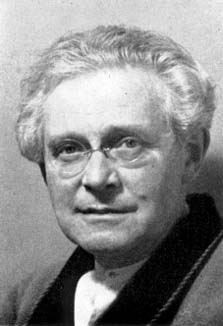


 تاريخ الرياضيات
تاريخ الرياضيات
 الرياضيات في الحضارات المختلفة
الرياضيات في الحضارات المختلفة 
 الرياضيات المتقطعة
الرياضيات المتقطعة
 الجبر
الجبر
 الهندسة
الهندسة 
 المعادلات التفاضلية و التكاملية
المعادلات التفاضلية و التكاملية 
 التحليل
التحليل
 علماء الرياضيات
علماء الرياضيات |
Read More
Date: 18-5-2017
Date: 22-5-2017
Date: 31-5-2017
|
Died: 22 March 1953 in Göttingen, Germany

Gustav Herglotz was born in Wallern but spent most of his childhood in Vienna. His father was Gustav Herglotz, a notary, who died when his son was three years old. His mother was Anna von Elbenbruck. It was in Vienna that he completed his school studies and entered the Technische Hochschule in 1899 to study mathematics and astronomy. There he formed a close friendship with three other students of mathematics, Heinrich Tietze, Hans Hahn and Paul Ehrenfest. They became known as the 'inseparable four'. Wishing to concentrate more on astronomy, Herglotz decided that he would be able to attend more appropriate courses at the University of Munich and so, after one year at the University of Vienna, he moved to Munich in 1900.
In Munich, Herglotz was advised by Hugo von Seeliger and Ludwig Boltzmann. He completed his doctoral studies in 1902, submitting his thesis Über die scheinbaren Helligkeitsverhältnisse eines planetarischen Körpers mit drei ungleichen Hauptträgheitsachsen. He published in 1902, in Vienna, part of this thesis as a 60 page paper with the same title as his thesis. The main motivation for his thesis was the discovery of the asteroid Eros. This was the first asteroid to be discovered that had an orbit closer to the sun than Mars. It was discovered on 13 August 1898 by Gustav Witt at the Urania Observatory in Berlin. Eros displayed large variations in brightness which we know to be due to its elongated shape. Herglotz, in his doctoral thesis, gave a geometric explanation of the variations in brightness of asteroids such as Eros.
In order to teach in universities Herglotz had to write an habilitation thesis and after working on it in Göttingen from 1902 to 1904 under Felix Klein, he submitted the thesis to the University of Göttingen. This earned him the right to lecture on mathematics and astronomy. Herglotz was a privatdozent at Göttingen from 1904 to 1907 when he was made an extraordinary professor. One problem that Herglotz worked on at this time was a fundamental problem of geophysics, extending Kelvin's theory on the earth's rigidity. He published Über die Elastizität der Erde bei Berücksichtigung ihrer variablen Dichte in 1905. Other papers he published in this period include Über die analytische Fortsetzung gewisser Dirichletscher Reihen (1906), Über die Gestalt der auf algebraischen Kurven nirgends singulären linearen Differentialgleichungen 2terOrdnung (1906), Über die Integralgleichungen der Elektronentheorie (1907), and Über das Benndorfsche Problem der Fortpflanzungsgeschwindigkeit der Erdbebenstrahlen (1907). In this last paper Herglotz solved Abel's integral equation which results from the inversion of measured seismic travel times into a velocity-depth function. This was an important result for it allowed models of the earth to be constructed from seismic data.
In 1908, one year after being made an extraordinary professor at Göttingen, Herglotz moved to an extraordinary professorship at the University of Vienna. Again Herglotz was to hold a post for only a year, for in 1909 he was offered a full professorship at the University of Leipzig. During his sixteen years in Leipzig, Herglotz supervised the doctoral studies of at least 25 students including Emil Artin.
Runge held the chair of Applied Mathematics at Göttingen from 1904 until he retired in 1925. Herglotz was appointed to fill the vacant chair which he held until 1946 when he was forced to resign due to ill health. At Göttingen, Herglotz lectured on a wide variety of topics, showing the breadth of his mathematical expertise. Among his lecture courses we mention Lie groups, continuum mechanics, geometrical optics, and functions with a positive real part. His lecture course on continuum mechanics was published in 1985, about 50 years after Herglotz gave the lectures. J J Cross writes:-
It is difficult to review as new a book published half a century out of its time, and a book which is more notes rather than a fully developed presentation. A reader should not expect to learn the mechanics of continua from this book as it is more in the tradition of Carslaw, Lichtenstein and even Carl Neumann rather than A E H Love or Horace Lamb: there is more technical mathematics than physical understanding and detailed calculation. There are two sections, one of five chapters on classical theory of the mechanics of continua based on Hamilton's principle and another of four chapters on partial differential equations. ... The author does show his usual clarity and elegance and the richness of his analysis appears in the many areas of application sketched in a paragraph or two, as one does in lectures.
Herglotz was married to Anna Lederer.
Books:
Articles:



|
|
|
|
لصحة القلب والأمعاء.. 8 أطعمة لا غنى عنها
|
|
|
|
|
|
|
حل سحري لخلايا البيروفسكايت الشمسية.. يرفع كفاءتها إلى 26%
|
|
|
|
|
|
|
جامعة الكفيل تحتفي بذكرى ولادة الإمام محمد الجواد (عليه السلام)
|
|
|